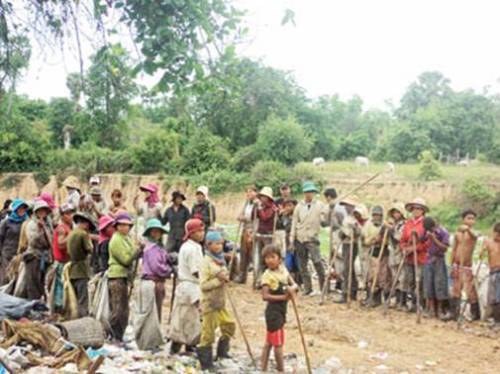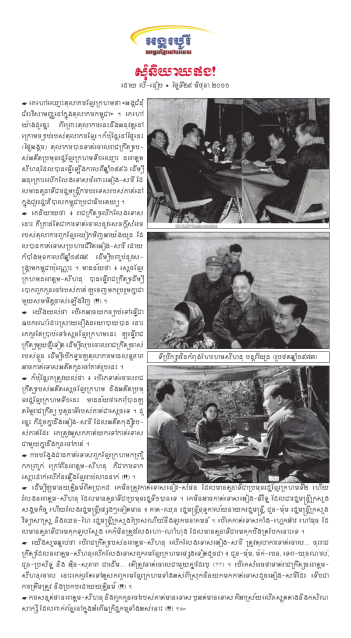 |
| Workers at the Siem Reap dump form orderly queues while they wait for the next rubbish truck to arrive.Photo by: MICHAEL SLOAN |
 |
| 17-year-old Pruen Sokhim, one of the youngsters forced to scavenge at Siem Reap’s dump each day.Photo by: MICHAEL SLOAN |
Friday, 24 June 2011
Michael Sloan and Thik Kaliyann
The Phnom Penh Post
PERHAPS it’s only in Cambodia that a rubbish dump can become a tourist attraction. Phnom Penh’s former Stung Meanchey dumpsite is a case in point, with HotelTravel.com saying: “If you ever wanted to remind your children how lucky they are, this is the place to bring them.”
But not so with Siem Reap’s garbage dump. Twenty kilometres out along National Road Six, there is a small village known only half jokingly by local NGOs as “Siem Reap’s dirty little secret”: a ramshackle slum built around the rim of a one-acre pit filled daily with garbage from the city.
More than 140 children and countless adults queue up alongside a column of garbage trucks each day, scraping a living by picking bottles and plastic out of the waste they deposit.
While Stung Meanchey garbage dump in Phnom Penh featured regularly in international news reports about poverty in Cambodia, the geographical isolation of Siem Reap’s dump means its inhabitants receive only limited assistance from a few under-resourced NGOs operating in the area.
Dug out of a rice field next to Rulu Village in April 2009, the city dump quickly became a gathering point for those with nowhere else to go, according to 20-year-old Sot Sa Em, who has lived on the rim of the pit with her three children since it opened.
“I work here because I don’t know where I can find another job,” she said. “It’s very difficult to survive but at least there is work. When my first daughter is older I want her to find another job, whatever she wants. It’s better than being here.”
Sot Sa Em explained that working life at the dump is dictated by the daily arrival of 10 smelly rubbish trucks.
As we arrived at the dump, one truck was reversing down the dirt road leading to the pit. It was chased by a group of children jostling for the best position from which to pick out the more valuable waste, usually Angkor beer bottles according to Sot Sa Em.
“Glass bottles are the most valuable,” she explained. “Four of them are worth 100 riel, and plastic or paper sells for around 100 riel a kilo. But it’s very difficult to get bottles because they are the most valuable. Sometimes when we rush the truck, it can be dangerous if they open the doors without warning because you can be hit and injured.”
Wearing gumboots and swathed in layers of heavy clothing, a group of around 20 people with sharpened sticks surrounded the truck. Forming two orderly lines behind the children who were the first to arrive, the group stood up to their waists in a mound of garbage as the truck opened its doors, before diving in to scoop the deposited plastic and glass into sacks.
Clustered around the pit are a number of better maintained wooden buildings where scavenged glass and plastic can be redeemed for cash, according to 17-year-old Pruen Sokhim, who told 7Days that the scrap dealers operating out of them sell their recycled goods several kilometres away at Samaki Market.
“They pay best for glass beer bottles, plastic bottles come second. If you are fast you can earn one dollar per day. Myself, I want to find another job to help my family but I have no choice. Working in the dump has become a habit.”
Paper, plastic and glass scrap dealers at the dump tend to segregate themselves by type, with those dealing in the most lucrative – glass – occupying the best positions upwind from the stench.
As we walked along the rim with Sokhim to deposit a load of paper with a Vietnamese scrap dealer, he joked that we must hate the smell, although if we stuck around for a few days we wouldn’t even notice.
“You have to ignore the smell if you want to find things that sell,” he said. “It’s hard because the most valuable rubbish is taken out in Siem Reap before it reaches the dump.”
At the nearby Kaliyann Mitt Centre operated by NGO Friends International, group monitor Kem Phalla said there were 145 children living in the dump according to a survey this year, with 42 attending local schools.
“This is the last place that people come to when they need work,” she said. “Some days the mothers go to the dump and leave their babies for someone to find and take care of, and then go and find a job farming or something else.”
Phalla, who coined the “dirty little secret” moniker for the dump, said casualties from working in its disease-filled environment trickle into the centre’s clinic every few days, with broken bones and infected cuts among the most common injuries.
“Usually if a wound is bad it’s become infected from handling glass bottles. At the centre we mostly try to divert children away from working in the dump towards other jobs. We send the children who want to find skills to our education centre in Siem Reap where they can learn tailoring, cooking and other trades.”
In addition to a small medical clinic, the Kaliyann Mitt Centre operates a pre-school for dump children as well as a drop-in centre for older kids, which Phalla notes has been successful in teaching hygiene and harm minimisation skills to dump inhabitants.
In addition to the Kaliyann Mitt Centre, children also attend three local schools, including nearby Anlong Pi Primary, which About Asia Schools volunteer coordinator Chris Smith said his organisation has been supporting with donations of uniforms and equipment over the past three months.
“Most of the families here can’t afford uniforms for students which is a prerequisite for attending government schools. Anlong Pi is one of the poorest schools in the area, with around 10 percent of the students here living on the dump itself.”
During an earlier visit to the school during Khmer New Year, about 100 Anlong Pi students were on hand to receive new uniforms and laptops donated by students from Melbourne Girls Grammar School in Australia. Smith hopes such philanthropy will increase, following the announcement of a new charity campaign by Hotel de la Paix.
“De la Paix has announced it will donate five uniforms to our students for every Mastercard transaction made between March and June,” he said. “It’s a big vote of confidence in the work we’re doing with Anlong Pi and other schools. The more uniforms and equipment we have, the more kids can attend school.”
But in the meantime life at the dump goes on as usual. Fifteen-year-old Li Mak, from Rulu Village, said that although his father’s job as a district official meant he could afford to attend nearby Bakong High School, he visits the dump once a day to catch up with friends who aren’t as fortunate.
“I go to school and when I have free time I come here to visit my friends,” he said. “When I finish school I would like to be a doctor and work here. No one should have to live here if they don’t want to.”







